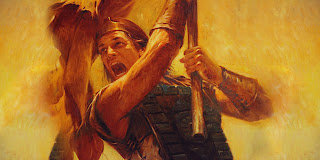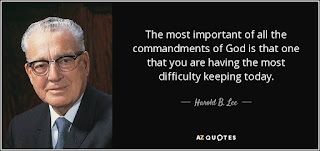The events portrayed in Helaman 6-12 are similar to
events today. In Helaman 6, the Nephites have become less righteous than the
Lamanites. Both Nephites and Lamanites are wealthy and richly blessed with
gold, silver, ore, linen, and cloth. The cycle of pride is in play and many of
the Nephites have become full of pride and fixated on their riches. In Helaman 6:17
we read, “For behold, the Lord has blessed them so long with the riches of the
world that they had not been stirred up to anger, to wars, nor to bloodshed;
therefore they began to set their hearts upon their riches; yea, they began to
seek to get gain that they might be lifted up one above another; therefore they
began to commit secret murders, and to rob and to plunder, that they might get
gain.”
Today’s society is so materialistic. We have flash
technology, phones, computers, TVs, and even computerised appliances. How many
people place more value on their goods than on God? Religion is not fashionable
today. The problem is, many of those who have the most, seem to be the most
miserable. All we need to do is look at the high rates of suicide, addiction, and
divorce, amongst today’s celebrities.
In Helaman 6, we are reminded that the laws in Nephite
society have been trampled underfoot (see Helaman 6:39). Cezoram, and
subsequently his son, are murdered while filling the role of Chief Judge. A
secret combination, the Gadianton Robbers, is able to take over the government.
I have been appalled watching the lead-up to the American elections. In New
Zealand we have our share of crooked politicians, but nothing as bad as the
current American political mad-house. No matter who wins the US election, the
USA will be in a sorry state! If Donald Trump wins, I can imagine a situation
similar to the turmoil in the Nephite government (about 30 years before the
birth of the Saviour).
 |
| Kishkumen & Gadianton by James Fullmer |
What is a secret combination? 30 Characteristics of Secret Combinations
gives us so much information about secret combinations. These 30
characteristics also appear in an article called Waking Up to Secret Combinations
(2011) by Darren Andrews. Secret combinations are Satanic in nature, founded
and supported by Satan himself. They involve oaths and signs, members protect
one another, and are highly secretive. The objectives of these secret
combinations are to achieve power and gain, and they often target government.
This sometimes allows murder on a national or international scale. The only way
to stop combinations is through conversion to the gospel. The Lamanites were
able to achieve this end. The Lamanites preached to the robbers, and they all
repented and forsook the Gadianton band. In Helaman 6:37 it says, “And it
came to pass that the Lamanites did hunt the band of robbers of Gadianton; and
they did preach the word of God among the more wicked part of them, insomuch
that this band of robbers was utterly destroyed from among the Lamanites.”
Do we have secret
combinations today? I remember a list made on the board in Sunday School, which
included: Mafia, Ku Klux Klan, Boko Haram, Taliban, Isis, Freemasons, Knights
Templar, etc.. Yes, a variety of these combinations do exist. The Freemasons
have been a part of society for hundreds of years, and the Italian Mafia also
has a history that dates back nearly 150 years. More recently. Asian Mafias
have risen to power in many great cities around the world. Today, there are
literally hundreds of terrorist groups. But, I believe, secret combinations include
hundreds, or even thousands, of smaller, less obvious groups. Motorbike gangs,
groups of crooked politicians, businessmen, or even police, may be included
under this category. Even smaller groups, like the Roast Busters, the group of
West Auckland young males who bragged on Facebook about having sex with drunk
and underage girls, may be considered a form of secret combination.
 One of the most dramatic and moving conversion
stories I have ever read and watched is From Mafia to Mormon. A
summary of this story can be found in LDSLIving.
I also have a DVD of the same name. This tells the story of Mario Facione, who
belonged to the Detroit mafia. He specialised in the theft and black market liquidation
of heavy construction equipment. He learned to read by struggling through a
copy of the Book of Mormon. He received a testimony of the Book of Mormon and was
baptised in 1981. When he went to his bishop for a temple recommend, he was
told that he could not serve two masters. Part of his story is how he closed
the door on his past with the mafia. This is a story that reminded me of the
Lamanite Gadianton robbers, who turned their backs on the secret combination
through repentance and conversion.
One of the most dramatic and moving conversion
stories I have ever read and watched is From Mafia to Mormon. A
summary of this story can be found in LDSLIving.
I also have a DVD of the same name. This tells the story of Mario Facione, who
belonged to the Detroit mafia. He specialised in the theft and black market liquidation
of heavy construction equipment. He learned to read by struggling through a
copy of the Book of Mormon. He received a testimony of the Book of Mormon and was
baptised in 1981. When he went to his bishop for a temple recommend, he was
told that he could not serve two masters. Part of his story is how he closed
the door on his past with the mafia. This is a story that reminded me of the
Lamanite Gadianton robbers, who turned their backs on the secret combination
through repentance and conversion.
The best thing we can do is to stay close to the
Spirit, if we hope to avoid Satan’s wiles and his power. In Helaman 7:20, Nephi questions
the wicked Nephites saying, “O, how could you have forgotten your God?” The
importance of “always remembering” our Saviour, by partaking of the Sacrament
every week, and by praying both night and morning, will be a shield and
protection to us.
In Helaman 8, we
see how close Nephi is to the Spirit. While testifying to the wicked Nephites,
he makes a remarkable prophecy of an event that only just occurred. In Helaman 8:27, he states, “…behold,
your judge is murdered, and he lieth in his blood; and he hath been murdered by
his brother, who seeketh to sit in the judgment-seat.” The Nephites send men to
check out the truthfulness of this prophesy. These men find the judge lying in
his own blood. They are so astounded by the fact that Nephi’s words are true,
that they faint to the ground. When the judge is discovered, the men who
fainted, are initially imprisoned and then released. The most surprising part
of this event is the reaction of the crowd to Nephi’s words. His words
constitute a detailed and accurate prophecy, yet most of the Nephites do not
accept him as a prophet. Their hearts are so hardened that they turn from him
and walk away. I find this astonishing!
In Helaman 12.
Mormon gives comments on the events he previously recorded. He mentions that at
the very time when the people are prosperous and possess precious things in
abundance, they “do forget the Lord their God, and do trample under their feet
the Holy One” (Helaman 12:2). He goes on to
say, “except he doth visit them with death and with terror, and with famine and
with all manner of pestilence, they will not remember him” (Helaman 12:3).
Brother Bill Beardall, in his Lesson 34, lists the weaknesses of fallen humanity, as recorded by Mormon in Helaman 12:4-6. These are:
Brother Bill Beardall, in his Lesson 34, lists the weaknesses of fallen humanity, as recorded by Mormon in Helaman 12:4-6. These are:
*Foolish
*Vain
*Evil and
devilish
*Quick to do
iniquity
*Slow to do good
*Quick to hearken
to the words of the evil one
*Quick to set
their hearts on the vain things of the world
*Quick to be lifted
up in pride
*Quick to boast
*Slow to remember
the Lord their God
*Slow to give ear
to God’s counsels
*Slow to walk in
wisdom’s paths
*Not desirous
that the Lord, their God, who created them, should rule and reign over them
*Eager to set
aside God’s counsel
*Not desirous
that God should be their guide
I read this
list, realising that these are the things I need to avoid. The key word again
seems to be “remember”. I need to always remember who I am, i.e. a beloved
daughter of heavenly parents. I need to remember my Saviour and Redeemer and
the power of the Atonement. I need to maintain an attitude of gratitude. I need
to remember that I can choose my actions but not the consequences of those
actions. I need to always retain an eternal perspective.



































